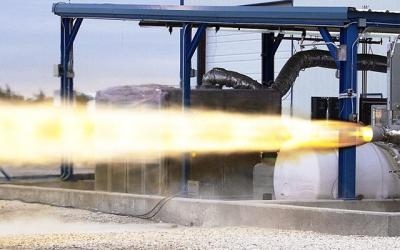Thu, Feb 02, 2012
New Video Shows SuperDraco Engine in Action
Space Exploration Technologies (SpaceX) has successfully test
fired SuperDraco, a powerful new engine that will play a critical
role in the company’s efforts to change the future of human
spaceflight. “SuperDraco engines represent the best of
cutting edge technology,” said Elon Musk, SpaceX CEO and
Chief Technology Officer. “These engines will power a
revolutionary launch escape system that will make Dragon the safest
spacecraft in history and enable it to land propulsively on Earth
or another planet with pinpoint accuracy.”

The SuperDraco is an advanced version of the Draco engines
currently used by SpaceX’s Dragon spacecraft to maneuver on
orbit and during reentry. As part of SpaceX’s
state-of-the-art launch escape system, eight SuperDraco engines
built into the side walls of the Dragon spacecraft will produce up
to 120,000 pounds of axial thrust to carry astronauts to safety
should an emergency occur during launch.
NASA’s Commercial Crew Program awarded SpaceX $75 million
in April of last year to begin work developing the escape system in
order to prepare the Dragon spacecraft to carry astronauts. Less
than nine months later, SpaceX engineers have designed, built and
tested the engine. In a series of recent tests conducted at the
company’s Rocket Development Facility in McGregor, Texas, the
SuperDraco sustained full duration, full thrust firing as well as a
series of deep throttling demonstrations.
SpaceX’s launch escape system has many advantages over
past systems. It is inherently safer because it is not jettisoned
like all other escape systems. This distinction provides astronauts
with the unprecedented ability to escape from danger at any point
during the launch, not just in the first few minutes. The eight
SuperDracos provide redundancy, so that even if one engine fails an
escape can still be carried out successfully.
SuperDracos can also be restarted multiple times if necessary
and the engines will have the ability to deep throttle, providing
astronauts with precise control and enormous power. In addition, as
a part of a recoverable Dragon spacecraft, the engines can be used
repeatedly, helping to advance SpaceX’s long-term goal of
making spacecraft more like airplanes, which can be flown again and
again with minimal maintenance between flights.
More News
The Industry Continues to be Rocked By Some Questionable Operations Recent investigations and a great deal of data has resulted in ANN’s SportPlane Resource Guide’s rep>[...]
Make Sure You NEVER Miss A New Story From Aero-News Network Do you ever feel like you never see posts from a certain person or page on Facebook or Instagram? Here’s how you c>[...]
Visual Approach Slope Indicator (VASI) An airport lighting facility providing vertical visual approach slope guidance to aircraft during approach to landing by radiating a directio>[...]
Airport Marking Aids Markings used on runway and taxiway surfaces to identify a specific runway, a runway threshold, a centerline, a hold line, etc. A runway should be marked in ac>[...]
Aero Linx: The Skyhawk Association The Skyhawk Association is a non-profit organization founded by former Skyhawk Pilots which is open to anyone with an affinity for the A-4 Skyhaw>[...]
 Unfortunate... ANN/SportPlane Resource Guide Adds To Cautionary Advisories
Unfortunate... ANN/SportPlane Resource Guide Adds To Cautionary Advisories ANN FAQ: Turn On Post Notifications
ANN FAQ: Turn On Post Notifications ANN's Daily Aero-Term (04.29.24): Visual Approach Slope Indicator (VASI)
ANN's Daily Aero-Term (04.29.24): Visual Approach Slope Indicator (VASI) ANN's Daily Aero-Term (04.28.24): Airport Marking Aids
ANN's Daily Aero-Term (04.28.24): Airport Marking Aids ANN's Daily Aero-Linx (04.28.24)
ANN's Daily Aero-Linx (04.28.24)



